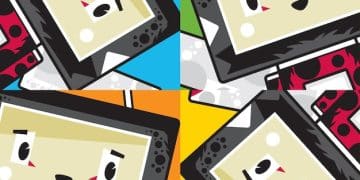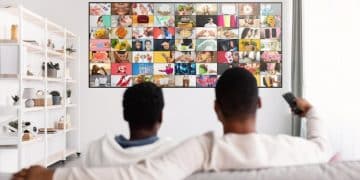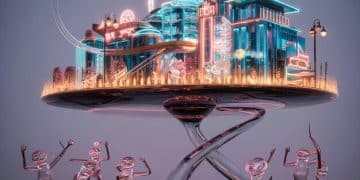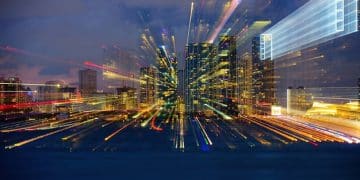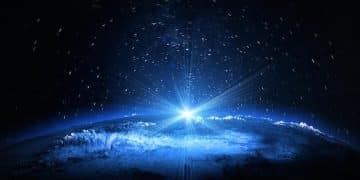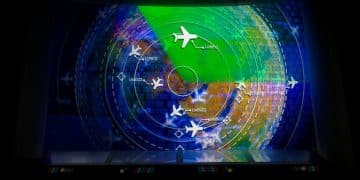The Evolution of Memes: From Viral Jokes to Cultural Commentary in 2025

Memes have evolved from simple viral jokes into a complex form of cultural commentary by 2025, reflecting societal shifts, political discourse, and collective consciousness, demonstrating their significant role in modern communication and information dissemination across digital platforms.
In an increasingly digital world, the rapid spread of ideas and jokes has found a unique vehicle: the meme. What began as quirky internet humor has undergone a profound transformation, evolving from simple viral jokes into a sophisticated form of cultural commentary. By 2025, the landscape of membranes is expected to be even more intricate and influential, reflecting global narratives and shaping perspectives. This journey from fleeting amusement to potent social statements highlights an intriguing shift in how we interpret and interact with information online.
The Genesis of Memes: A Digital Big Bang
The origins of memes can be traced back to the early days of the internet, but their conceptual roots predate digital technology. Richard Dawkins coined the term “meme” in 1976 to describe a unit of cultural information transmitted from mind to mind. In the digital realm, this concept truly took hold, accelerating the spread and mutation of ideas at an unprecedented rate. Early internet memes were often simple, image-based macros, characterized by bold, white text with a black outline, overlayed on popular images. These initial forms served primarily as lighthearted entertainment, resonating with online communities through shared experiences and inside jokes. They were the digital equivalent of chain letters or playground chants, spreading through nascent social media platforms and forums.
The early 2000s saw the rise of iconic memes like “All Your Base Are Belong to Us” and “Dancing Baby,” showcasing the raw, unfiltered nature of early internet virality. These memes often emerged organically from obscure corners of the web, propelled by the sheer novelty of shared digital content. The barrier to entry was low, allowing anyone with a basic understanding of image editing to create and disseminate their own versions. This democratized content creation, laying the groundwork for the more complex and layered memes that would follow. The sheer volume of new content meant that while many memes quickly faded into obscurity, a select few achieved widespread recognition, becoming foundational elements of internet culture.
Early Viral Sensations and Their Impact
The first generation of truly viral memes demonstrated the internet’s power to rapidly disseminate specific pieces of content, often with little to no explanation required. Their success lay in their universality and ease of replication.
- 😂 LOLcatz: Simple images of cats with humorous, grammatically incorrect captions.
- 💃 Dancing Baby (Baby Cha-Cha): One of the very first viral video memes, a CGI baby performing a dance.
- 🐸 Pepe the Frog: Initially an innocent comic character, later controversially adopted for various purposes.
These pioneering efforts established the template for future viral phenomena, showing how visual content, combined with short, catchy phrases, could capture collective attention and incite widespread sharing. Their impact paved the way for the more nuanced and politically charged memes we see today, proving that internet content could indeed become a dominant form of popular culture. The ease of creation and sharing became a hallmark of internet culture, distinguishing it from traditional media.
The transition from simple jokes to broader cultural phenomena was gradual, fueled by technological advancements and the increasing ubiquity of internet access. As bandwidth improved and social media platforms became more sophisticated, memes evolved from static images to dynamic videos, GIFs, and even interactive formats. This technological progression allowed for greater complexity in meme creation and interpretation, reflecting a maturing digital ecosystem. The very nature of memetic spread moved beyond niche online communities, infiltrating mainstream media and everyday conversation. This expansion marked a critical turning point, signifying that memes were no longer confined to subcultures but had become a ubiquitous part of modern communication.
The early foundational period of memes underscored several key aspects: their ephemeral nature, their ability to foster community through shared humor, and their latent potential as a tool for communication beyond mere entertainment. Understanding this genesis is crucial to appreciating their current role as powerful instruments of cultural commentary and social discourse in 2025. It illustrates a clear trajectory from playful novelty to significant sociocultural influence. This initial phase, while seemingly simple, laid the complex groundwork for the sophisticated memetic landscape we navigate today.
The Rise of Relatability and Niche Memes
As internet communities grew and diversified, so too did the complexity and specificity of memes. The early 2010s saw a significant shift from broad, universally understood jokes to more nuanced, often highly relatable content that spoke directly to specific demographics and subcultures. This period marked the emergence of “niche memes,” which thrived on shared experiences, inside jokes, and micro-culturalreferences that resonated deeply within smaller, tightly-knit online groups. This evolution allowed memes to become more reflective of diverse realities, moving beyond a one-size-fits-all approach to humor. The ability to find a meme that perfectly articulated a unique feeling or situation created a powerful sense of belonging and validation for users.
The development of platforms like Reddit, Tumblr, and early Facebook groups facilitated the growth of these niche communities. Users could easily share content tailored to their specific interests, whether it was based on academic struggles, professional grievances, mental health awareness, or highly specific fandoms. This hyper-personalization of memes meant that while they might not achieve global viral status, their impact within their intended audience was profound, fostering stronger connections and a deeper sense of shared identity. This era demonstrated that virality wasn’t always about mass appeal, but often about intense resonance within a dedicated audience.
From Mass Appeal to Micro-Communities
The shift towards niche memes paralleled the fragmentation of online spaces, with users gravitating towards communities that mirrored their offline interests and experiences. This specialization led to a richer, more diverse memetic landscape.
- 🎭 Fandom Memes: Highly specific jokes understood only by fans of a particular show, game, or book.
- 🎓 Academic Memes: Relatable humor for students and researchers about studying, deadlines, and academic life.
- ⚕️ Mental Health Memes: Sharing humorous or empathetic content about anxiety, depression, and other mental health struggles, fostering connection.
These examples highlight how memes began to serve as a form of cultural shorthand, quickly conveying complex emotions or ideas to those in the know. They became an internal language for groups, strengthening bonds and validating shared perspectives. The growth of these niche communities also paved the way for more sophisticated memetic expressions that could critically engage with social and political topics. This personalization of content helped users feel more seen and understood, moving beyond generic humor.
The ability of memes to capture specific moods, anxieties, or triumphs made them incredibly powerful tools for self-expression and community building. This period saw memes become less about broadcasting a joke to everyone and more about whispering a secret to those who truly understood. The rise of image generators and easier editing tools further democratized meme creation, allowing individuals to quickly produce content that spoke directly to their lived experiences. This accessibility meant that niche content could be created and shared instantly, responding to real-time events and sentiments within specialized groups. The rapid feedback loop of online communities encouraged this specificity, as creators saw immediate validation for truly relatable content.
By understanding the nuanced dynamics of niche memes, we can see how the memetic ecosystem became far more intricate, laying the groundwork for memes to evolve beyond mere humor and into a robust form of cultural commentary. This phase showed that memes could be both highly personal and broadly impactful within their specific contexts. It was a crucial step in their journey towards becoming critical lenses through which we view and discuss the world in 2025. This era solidified the role of memes as flexible and adaptable conduits for a wide range of human experiences.
Memes as Social and Political Barometers
As digital literacy increased and internet penetration broadened, memes naturally began to reflect and influence social and political discourse. By the mid-2010s, their role transcended simple humor, evolving into powerful tools for cultural commentary, political satire, and even social activism. Memes became concise, often cutting, barometers of public sentiment, capable of encapsulating complex arguments, frustrations, or aspirations in easily digestible formats. This transformation allowed them to serve as a rapid-fire communication method in an increasingly interconnected and politically charged world. They could convey nuanced stances or emotional reactions that might take paragraphs to articulate in traditional text.
The speed at which memes could spread made them particularly effective during political campaigns, social movements, and times of significant cultural change. They offered a low-barrier-to-entry form of participation, allowing individuals to express their views, challenge narratives, and mobilize collective action without needing to compose lengthy manifestos. From protest movements to viral political jabs, memes embodied a new form of digital dissent and engagement. They often highlighted absurdities or hypocrisies in clever and memorable ways, making difficult topics approachable.
Leveraging Humor for Critical Commentary
Memes often use humor, irony, and satire to critique social norms, political figures, or systemic issues. This comedic veneer makes difficult conversations more accessible and shareable.
- 🗳️ Political Satire: Mocking politicians or policies to highlight perceived flaws or inconsistencies.
- ✊ Social Justice Memes: Raising awareness and fostering solidarity around issues like climate change or equality.
- 🌍 Global Event Commentary: Reacting to major world events with shared humor or expressions of collective sentiment.
Through these applications, memes became a form of collective consciousness, reflecting the prevailing moods and opinions of digital communities. Their re-appropriation and remixability allowed for continuous adaptation and response to evolving events, making them highly dynamic instruments of commentary. This adaptability ensures their continued relevance in fast-paced news cycles.
However, this power comes with a critical caveat: the ease of spread and lack of traditional editorial oversight also made memes susceptible to manipulation and the dissemination of misinformation. The same viral mechanisms that allowed for insightful commentary could also be exploited for propaganda or the normalization of harmful ideologies. Discerning fact from fiction in a world saturated with memetic content became a new challenge for digital citizens. This dual nature underscores the importance of critical media literacy in interpreting memetic messages. The impact of a meme, positive or negative, often depends on the context and the audience’s existing biases.
By 2025, memes have solidified their position not just as fleeting jokes, but as essential components of democratic discourse and cultural reflection. They are a mirror held up to society, albeit a distorted one at times, showing us our collective anxieties, hopes, and frustrations. Their evolution highlights the inherent connection between digital culture and real-world societal dynamics. This role as a social and political barometer is one of the most significant transformations in the history of membranes, indicating their deep integration into contemporary life.
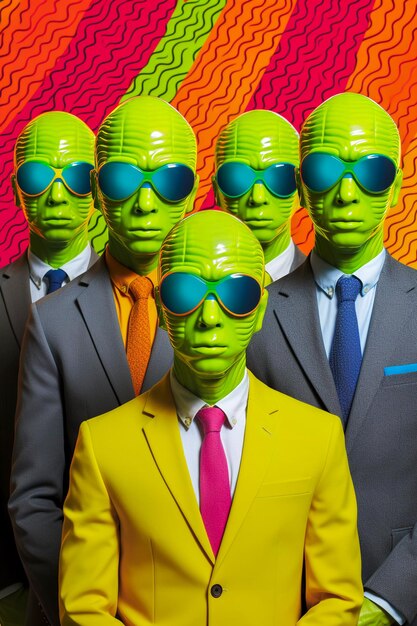
The Aesthetics and Artistry of Memes
Beyond their function as vehicles for humor or commentary, memes have increasingly developed their own unique aesthetic and artistic conventions. What began as simple, often crude, image macros has evolved into a sophisticated visual language, demonstrating a surprising degree of artistry and creativity. By 2025, meme creation often involves a nuanced understanding of visual composition, comedic timing, and psychological resonance, transforming what some might dismiss as mere internet jokes into a legitimate form of digital folk art. This evolution reflects a growing maturity in online content creation, where creators pay attention to subtle visual cues and emotional impact.
The consistent emergence of new templates, visual styles, and narrative structures within memes points to an underlying collective creative process. Memes can be minimalist, surreal, deeply layered with multiple references, or visually complex, experimenting with different forms to achieve maximum impact. This artistic development is fueled by the rapid exchange of ideas and the constant push to innovate within online communities, leading to new ways of conveying meaning through visuals and text. Creators often draw inspiration from art history, contemporary design, and popular culture, blending them into something distinctly memetic.
Emerging Styles and Creative Techniques
The visual artistry in memes goes beyond mere image manipulation, often incorporating elements of fine art, graphic design, and storytelling.
- 🖼️ “Deep Fried” Memes: Images repeatedly re-saved and compressed, resulting in a distorted, grainy, and hyper-saturated aesthetic.
- 🧠 Surreal Memes: Abstract, non-sensical, and often unsettling images that challenge conventional understanding of humor.
- 📝 Explainer Memes: Visually breaking down complex concepts or current events into understandable, bite-sized pieces.
These styles represent a conscious effort by creators to push the boundaries of what a meme can be, experimenting with visual effects and narrative structures. They demonstrate that memetic creation is not merely repetitive but often involves genuine artistic intent and a desire to communicate in novel ways. The sheer variety in meme styles ensures their continued relevance and appeal.
Furthermore, the accessibility of sophisticated editing software and AI-powered image generation tools has democratized this artistic process. Anyone can now create visually compelling memes, leading to an explosion of creativity and personalized expressions. This accessibility ensures that the aesthetic evolution is continuous, with new trends and styles emerging almost daily. The interplay between human creativity and technological tools is constantly pushing the boundaries of what is possible in memetic art. The iterative nature of meme creation, where one meme inspires countless variations, also contributes to this artistic progression.
Understanding the aesthetic and artistic aspects of memes is crucial for recognizing their cultural significance. They are not merely transient images but a dynamic art form that reflects anxieties, desires, and sensibilities of the digital age. By 2025, the visual lexicon of memes is incredibly rich and varied, proving that even seemingly simple internet jokes can harbor complex artistic merit. This recognition elevates memes beyond just humor, placing them firmly within the broader landscape of contemporary art and communication.
The Economics and Monetization of Memes
In the digital economy, few cultural phenomena have translated as seamlessly into commercial value as memes. What started as voluntary, grassroots content creation has, by 2025, become a significant component of online marketing, branding, and even individual income generation. The intrinsic virality and relatability of memes make them incredibly effective tools for engagement, captivating audiences in ways traditional advertising often struggles to achieve. Businesses and individuals have recognized that leveraging the power of memes can lead to exponential reach and authentic connection with consumers.
Companies increasingly integrate memes into their marketing strategies, using them to create relatable content, boost brand awareness, and foster a sense of community with their target demographics. This “meme marketing” often feels less like an advertisement and more like a shared cultural experience, making it highly effective. From fast-food chains to luxury brands, the strategic use of memes underscores their undeniable commercial appeal. The best campaigns are those that skillfully integrate brand messaging without feeling forced or disingenuous, maintaining the meme’s organic authenticity. However, the transient nature of memes also means that brands must act quickly and authentically, lest their attempts at humor fall flat or appear outdated.
Brands and Creators Leveraging Memes for Profit
The commercialization of memes takes various forms, from direct advertising to individual creators building entire careers around memetic content.
- 📈 Brand Marketing: Companies creating or adopting memes to connect with younger audiences and appear culturally relevant.
- 🎨 Influencer Economy: Meme creators gaining massive followings, leading to brand partnerships and merchandising.
- 🚀 Crypto and NFT Memes: The rise of digital assets represented by memes, sometimes fetching high prices.
This monetization reflects a broader trend in the creator economy, where individual talent and cultural understanding can be directly translated into economic value. The low barrier to entry for meme creation means that virtually anyone can participate in this economy, turning viral content into tangible assets. The ability of a meme to capture collective attention is increasingly seen as a valuable commodity.
Beyond direct marketing, the rise of “meme stock” phenomena and the booming market for Non-Fungible Tokens (NFTs) have further solidified the economic significance of memes. Specific memes, or original artworks inspired by them, have been sold for significant sums, showcasing their value as unique digital assets. This intersection of internet culture, finance, and technology represents a new frontier in the valuation of digital content. The inherent scarcity and historical significance attributed to some meme NFTs have driven their prices remarkably high, often baffling traditional art collectors.
The economics of memes by 2025 clearly illustrate that they are more than just fleeting jokes; they are valuable intellectual properties and powerful marketing tools that drive engagement and generate revenue. Their evolution reflects a mature digital landscape where cultural phenomena are intimately intertwined with commercial opportunities. This transformation highlights the dynamic relationship between cultural trends and economic ingenuity, making memes a fascinating case study in digital entrepreneurship.
Challenges and Controversies in the Meme-osphere
While memes have proven to be powerful tools for communication and cultural commentary, their rapid evolution and decentralized nature have also given rise to significant challenges and controversies. By 2025, the “meme-osphere” is a complex ecosystem where creativity, humor, and social critique often intersect with issues of misinformation, hate speech, and copyright infringement. The very qualities that make memes so effective—their ease of creation, rapid spread, and often ambiguous meaning—also make them susceptible to misuse and unintended consequences. This dual nature requires constant vigilance and critical engagement from users and platforms alike.
One of the most persistent issues is the spread of misinformation and disinformation disguised as humor. Memes can quickly encapsulate and disseminate false narratives, making them particularly difficult to fact-check and challenging the public’s ability to discern truth. The emotional resonance of memes often bypasses critical thinking, allowing harmful ideas to spread unchecked. This problem is exacerbated by the tendency of algorithms to favor highly engaging, emotionally charged content, regardless of its factual basis. The speed at which such content goes viral means that by the time debunking efforts are made, the false narrative may have already taken root in collective consciousness.
Navigating the Ethical Minefield of Memes
The challenges surrounding memes are multifaceted, touching upon ethical, legal, and social dimensions.
- ❗ Misinformation: Memes used to spread false or misleading information, often with political or social agendas.
- 🚫 Hate Speech: The appropriation of popular meme formats to convey discriminatory or hateful messages.
- ⚖️ Copyright and Attribution: Issues surrounding the ownership of original images or concepts used in rapidly evolving meme formats.
These issues highlight the urgent need for critical digital literacy and responsible content creation and sharing. Platforms and users alike grapple with how to balance freedom of expression with the imperative to combat harmful content. The fluid nature of memes also makes it difficult to trace origins or assign responsibility, complicating efforts to police their misuse.
Furthermore, the use of memes in political and social discourse has, at times, blurred the lines between satire and genuine malice. Iconic memes have been controversially adopted by extremist groups, giving seemingly innocuous images a darker, more divisive meaning. This re-appropriation presents a dilemma for platforms and users: how to manage content when its meaning can be radically altered by context and intent. The ongoing debate about content moderation on social media platforms is deeply intertwined with these memetic challenges, as algorithms struggle to understand nuance.
By 2025, understanding these challenges is crucial for navigating the meme-osphere responsibly. While memes offer incredible potential for humor and commentary, they also carry the significant risk of normalizing harmful ideas or misleading narratives. Efforts to promote digital literacy, develop more sophisticated content moderation tools, and foster a greater sense of accountability among creators and sharers will be essential in shaping a healthier memetic landscape. This ongoing struggle underscores the power and the peril inherent in a truly decentralized communication medium.
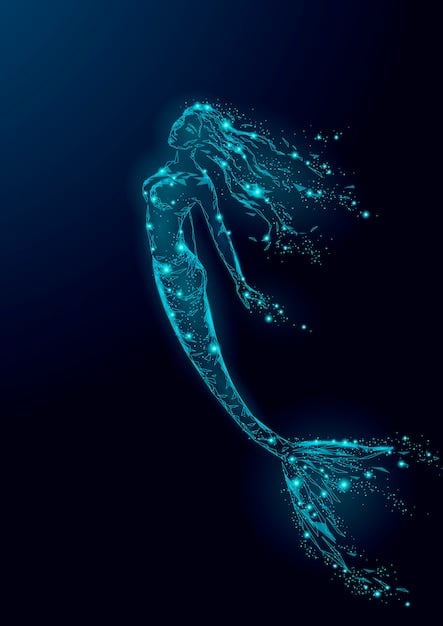
The Future of Memes: AI, AR, and Beyond in 2025
Looking ahead to 2025, the future of memes is poised for even more dramatic transformations, driven largely by advancements in artificial intelligence (AI), augmented reality (AR), and real-time content generation. These technologies are not only accelerating the creation and dissemination of memes but also fundamentally altering their forms, interactiveness, and pervasive cultural impact. The lines between creator and audience, and between digital and physical realities, are set to blur further, making memes an even more integrated part of our daily lives. The ongoing development of sophisticated AI models capable of understanding and generating human-like content promises a new era for memetic expression.
Generative AI, in particular, is revolutionizing meme creation. AI models can now produce highly realistic or surreal images and videos based on textual prompts, opening up endless possibilities for novel meme formats. This includes AI-generated memetic characters, dynamically changing backgrounds, or even entire meme narratives conceptualized and executed by algorithms. The speed at which AI can iterate on themes and visual styles means that the lifecycle of memes could accelerate even further, with new trends emerging and fading in mere hours. This raises intriguing questions about authorship and the future of human creativity in a world of AI-assisted content. The ability to generate unique content on demand will democratize meme creation even further.
Technological Frontiers Shaping Memetic Evolution
Future memes will likely leverage cutting-edge technologies to become more immersive, interactive, and personalized.
- 🤖 AI-Generated Memes: Algorithms creating original, contextually relevant memes from scratch or adapting existing ones.
- 🕶️ Augmented Reality (AR) Memes: Interactive memes overlayed onto the real world through smartphone apps or AR glasses, offering immersive experiences.
- 🗣️ Deepfake Memes: Realistic, AI-generated videos or audio of individuals saying or doing humorous (or controversial) things.
These technological advancements suggest a future where memes are not just static images or videos but dynamic, personalized experiences. Imagine AR memes that pop up on your street corner, or deepfake memes tailored to your personal interests, delivered through personalized feeds. This personalization could lead to even more fragmented meme communities, but also to deeper, more engaging individual experiences. The ethical implications, particularly concerning deepfakes and the spread of synthetic media, will undoubtedly be a major area of concern.
Moreover, the burgeoning metaverse concept will likely provide new canvases for memetic expression. In virtual worlds, memes could become interactive objects, virtual performances, or even architectural elements, extending their commentary beyond flat screens into shared digital spaces. The integration of memes into these immersive environments could unlock entirely new forms of storytelling and collective expression. The sheer interactivity of metaverse platforms will allow for more dynamic and responsive meme consumption.
By 2025, the “meme-osphere” will be driven by powerful technological forces, making memes more adaptive, personalized, and deeply embedded in our digital and physical realities. While these innovations promise exciting new forms of humor and commentary, they also necessitate a greater public understanding of AI and digital ethics. The future of memes will undoubtedly be a fascinating blend of human creativity and technological prowess, continuing their journey from viral jokes to profound cultural commentary. This ongoing integration of technology will redefine what a meme truly is.
| Key Aspect | Brief Description |
|---|---|
| 🚀 Viral Origins | Started as simple jokes, spreading through early internet culture. |
| 💬 Cultural Commentary | Evolved into tools for social and political critique. |
| 💰 Economic Impact | Now significant in marketing, branding, and creator economy. |
| 🧠 Future Trends | AI, AR, and Metaverse integration reshape their creation and consumption. |
Frequently Asked Questions About Memes
In 2025, memes serve primarily as a versatile form of cultural commentary and social discourse, moving beyond mere humor. They encapsulate complex ideas, reactions, and societal sentiments, acting as concise digital communication tools in a fast-paced information environment. They are integral to online identity and community bonding.
By 2025, AI has significantly accelerated and diversified meme creation. Advanced generative AI models can produce original, contextually relevant images and videos, enabling rapid iteration and personalization of memes. This allows for more sophisticated visual narratives and a constant influx of novel content, impacting the speed of trends.
Yes, many consider memes a legitimate form of digital folk art. Their creation often involves a nuanced understanding of visual composition, comedic timing, and psychological resonance. With the emergence of diverse aesthetic styles and complex visual narratives, memes demonstrate significant artistic merit and creative expression in the digital age.
Key challenges include the rapid spread of misinformation and disinformation, the propagation of hate speech through re-appropriation, and complex issues surrounding copyright and attribution. The decentralized nature of memes makes it difficult to control harmful content, necessitating greater digital literacy and robust content moderation efforts.
In 2025, memes are significant economic drivers, primarily through meme marketing, branding, and the creator economy. Brands leverage memes for engagement and awareness, while individual creators monetize their viral content. The rise of meme-related NFTs and “meme stocks” further highlight their substantial commercial and financial value.
Conclusion
The journey of memes from simple, often quirky viral jokes to profound cultural commentary by 2025 is a testament to the dynamic and adaptive nature of digital communication. They have transcended mere entertainment, becoming powerful vehicles for expressing shared human experiences, critiquing societal norms, and mobilizing public sentiment. As technology continues to advance, particularly with AI and AR, memes are poised to become even more pervasive and sophisticated, offering new frontiers for creativity, social interaction, and political discourse. While challenges like misinformation persist, the ongoing evolution of memes underscores their undeniable role as an indispensable lens through which we understand and engage with the complexities of our contemporary world.
